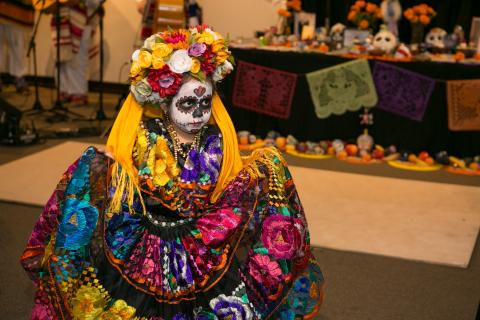
EUGENE, Ore. -- (October 23, 2018) – This year’s Día de los Muertos (Day of the Dead) celebration returns to the Jordan Schnitzer Museum of Art on the University of Oregon campus on Friday, November 1 and Saturday, November 2 from 6:00 to 9:00 p.m. each evening. Guest are invited to join a processional at 5:30 p.m. at the EMU amphitheater to journey to the museum together. The free celebrations are open to the community and feature dancing, poetry readings, live music, traditional Mexican ofrendas and Day of the Dead bread, prints, and paintings by artists in Mexico, and art activities for all ages.
Each evening, Pasatono Orquesta, a group of musicians and singers dedicated to rescuing and presenting traditional Oaxacan music, will perform with dancers from Identidad y Folclor, based in Guanajuato, Mexico, for a lively cultural event. Raymundo Gonzalez Nieto, an artist from Guanajuato, Mexico, will exhibit his colorful papier- mâché skulls that are elaborately painted with stylized natural designs. Prints and paintings by artists based in Guanajuato, Mexico, will also be on view.
Constructed by the students of Oak Hills School and the UO student organization MEChA (Movimiento Estudiantil Chicanos de Aztlán), traditional Día de los Muertos ofrendas (also known as Day of the Dead altars), will be on display. The altar is a customary part of the holiday that is meant to honor and receive the souls of the departed.
”Día de los Muertos is a festive and thoughtful holiday in Mexico and some parts of Central and South America,” says Cheryl Hartup, JSMA associate curator of Latin American Art. “The unique tradition is celebrated by Latinxs and Chicanxs in the United States, and an ever-increasing general public.”
Thousands of years ago, in the valley of southern Mexico, Mayas, Zapotecas, Mixtecas, and Aztecas honored their dead with elaborate ceremonies, dances and rituals. After Cortez conquered Mexico in the 16th century and with the introduction of Catholicism, the indigenous celebration of the dead was moved to coincide with the religious celebrations of All Saints Day and All Souls Day. The intersection of these celebrations has given way to the Día de los Muertos that we know today, which includes the tradition of altars with food, a glass of water, candles, flowers, papel picado (paper cut-outs), and photographs of the deceased alongside those of saints.
In Mexico, there are wide variances of this celebration between regions. However, traditionally on November 1, Día de los Muertos Chiquitos is observed to honor departed children. This evening is also sometimes referred to as la Noche de Duelo (The Night of Mourning) and is marked by a candlelight procession to the cemetery. On November 2, Día de los Muertos, the spirits of the dead are remembered, and families gather to visit the graves of their ancestors.
The day is passed cleaning and decorating the gravesites of the departed, and time is spent together as a family and as a community. Families bring the favorite foods and libations of their loved ones to the gravesites, along with a picnic lunch for themselves. Sugar skulls and toys are given to the children, which emphasize early on that death is an important part in the cycle of life. This is a happy celebration for families to remember the pleasant times shared with departed family members.
The Día de los Muertos celebration at the JSMA is co-sponsored by Oak Hill School in conjunction with the Jordan Schnitzer Museum of Art, UO MEChA (Movimiento Estudiantil Chicanos de Aztlán), Adelante Sí, University of Oregon Division of Equity and Inclusion, Instituto Estatal de la Cultura de Guanajuato, and Instituto Estatal de Atención al Migrante Guanajuatense y sus familias.
About the Jordan Schnitzer Museum of Art
The University of Oregon's Jordan Schnitzer Museum of Art is a premier Pacific Northwest museum for exhibitions and collections of historic and contemporary art. The mission of the museum is to enhance the University of Oregon’s academic mission and to further the appreciation and enjoyment of the visual arts for the general public. The JSMA features significant collections galleries devoted to art from China, Japan, Korea, Europe, and the Americas as well as changing special exhibition galleries. The JSMA is one of seven museums—and the only academic art museum-- in Oregon accredited by the American Alliance of Museums.
The Jordan Schnitzer Museum of Art is located on the University of Oregon campus at 1430 Johnson Lane. Museum hours are 11 a.m. to 8 p.m. Wednesdays, and 11 a.m. to 5 p.m. Thursdays through Sundays. Admission is $5 for adults and $3 for senior citizens. Free admission is given to ages 18 and under, JSMA members, college students with ID, and University of Oregon faculty, staff and students. For information, contact the JSMA, 541-346-3027.
Contact: Debbie Williamson Smith, 541-346-0942, debbiews@uoregon.edu
Links: Jordan Schnitzer Museum of Art, http://jsma.uoregon.edu






